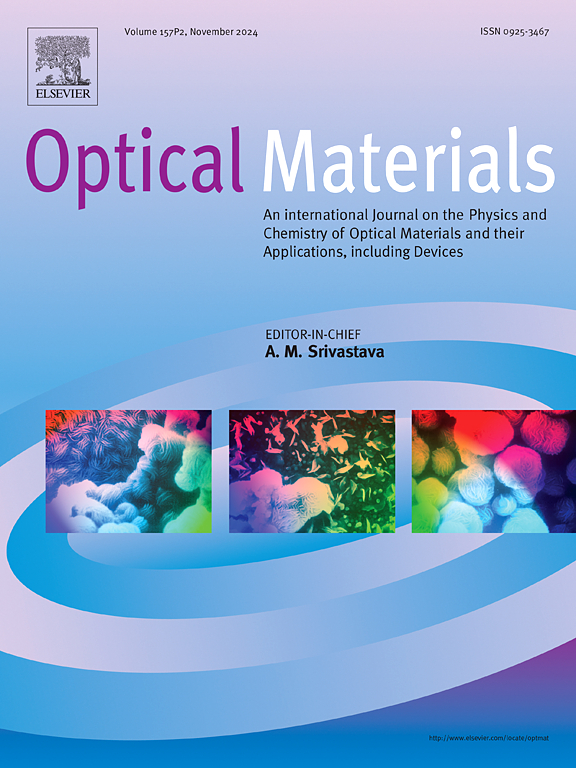Enhanced mid-infrared luminescent properties of Ho,Re:CNGG (RePr, Eu, Tb) crystals co-doped with deactivating ions
IF 3.8
3区 材料科学
Q2 MATERIALS SCIENCE, MULTIDISCIPLINARY
引用次数: 0
Abstract
Crystals of 2 at.% Ho:CNGG co-doped with 0.2 at.% deactivating ions (Pr3+, Eu3+, Tb3+) were successfully grown using the micro-pulling-down (μ-PD) technique for the first time. Detailed investigations were conducted on absorption spectra, fluorescence spectra, and lifetime decay curves. The 2 at.% Ho, 0.2 at.% Pr:CNGG crystal exhibits a broad absorption band at 1142 nm, with full width at half maximum (FWHM) values of 88.5 nm. This crystal composition shows the most intense emission at 2860 nm, with FWHM of 181 nm. The luminescent lifetime ratio (5I6/5I7) and transition efficiencies of Ho,Pr:CNGG at approximately 3.0 μm are also the highest, measuring 0.107 and 70.48 % (0.105 and 69.96 % for Ho,Eu:CNGG, 0.090 and 65.08 % for Ho,Tb:CNGG). These results suggest that Pr3+ demonstrates superior performance in mitigating self-termination and enhancing population inversion compared to the other deactivating ions.
失活离子共掺杂Ho,Re:CNGG (RePr, Eu, Tb)晶体增强中红外发光性能
2 at晶体。% Ho:CNGG共掺杂0.2 at。首次利用微拉降(μ-PD)技术成功培养了%的失活离子(Pr3+, Eu3+, Tb3+)。对其吸收光谱、荧光光谱和寿命衰减曲线进行了详细的研究。2 at。% Ho, 0.2 at。% Pr:CNGG晶体在1142 nm处表现出较宽的吸收带,半峰全宽为88.5 nm。该晶体在2860 nm处显示出最强烈的发射,FWHM为181 nm。Ho,Pr:CNGG在3.0 μm左右的发光寿命比(5I6/5I7)和跃迁效率也最高,分别为0.107和70.48% (Ho,Eu:CNGG为0.105和69.96%,Ho,Tb:CNGG为0.090和65.08%)。这些结果表明,与其他失活离子相比,Pr3+在减轻自终止和促进种群反转方面表现出更好的性能。
本文章由计算机程序翻译,如有差异,请以英文原文为准。
求助全文
约1分钟内获得全文
求助全文
来源期刊

Optical Materials
工程技术-材料科学:综合
CiteScore
6.60
自引率
12.80%
发文量
1265
审稿时长
38 days
期刊介绍:
Optical Materials has an open access mirror journal Optical Materials: X, sharing the same aims and scope, editorial team, submission system and rigorous peer review.
The purpose of Optical Materials is to provide a means of communication and technology transfer between researchers who are interested in materials for potential device applications. The journal publishes original papers and review articles on the design, synthesis, characterisation and applications of optical materials.
OPTICAL MATERIALS focuses on:
• Optical Properties of Material Systems;
• The Materials Aspects of Optical Phenomena;
• The Materials Aspects of Devices and Applications.
Authors can submit separate research elements describing their data to Data in Brief and methods to Methods X.
 求助内容:
求助内容: 应助结果提醒方式:
应助结果提醒方式:


